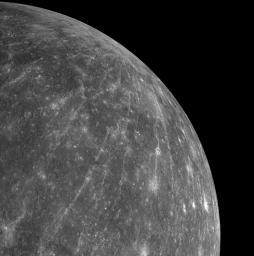
|
A Big and Brilliant Ray System
- Click the image above for a larger view
- Full-Res JPEG (1018 x 1024) (129.8 kB)
- Full-Res TIFF (1018 x 1024) (1.0 MB)
Caption:
In one of the first images transmitted to Earth following MESSENGER's second Mercury flyby, a full-planet departure view (see PIA11245 ) showed a crater in the northern region near the planet's limb with an impressively large system of rays. The WAC image shown here is part of a 3x3 mosaic and provides a closer look at that extensive ray system. The source crater for the ray system can be seen in detail in a previously released high-resolution Narrow Angle Camera (NAC) image (see PIA11356 ). Astronomers who collected ground-based radar images from the Arecibo Observatory had identified this rayed crater prior to MESSENGER's flyby and referred to it as feature "B." Now optical images from MESSENGER's flyby have revealed just how big and brilliant this ray system of feature "B" really is.
Date Acquired:
October 6, 2008
Image Mission Elapsed Time (MET):
131772423
Instrument:
Wide Angle Camera (WAC) of the Mercury Dual Imaging System (MDIS)
WAC Filter:
7 (750 nanometers)
Resolution:
2.2 kilometers/pixel (1.4 miles/pixel) in the lower left of the image
Scale:
Mercury's radius is 2440 kilometers (1520 miles)
Spacecraft Altitude:
12,500 kilometers (7,800 miles)
Background Info:
These images are from MESSENGER, a NASA Discovery mission to conduct the first orbital study of the innermost planet, Mercury. For information regarding the use of images, see the MESSENGER image use policy .
Cataloging Keywords:
| Name | Value | Additional Values |
|---|---|---|
| Target | Mercury | |
| System | ||
| Target Type | Planet | |
| Mission | MESSENGER | National Astronomy and Ionosphere Center (NAIC) |
| Instrument Host | MESSENGER | Arecibo Observatory |
| Host Type | Orbiter | Ground-Based Observatory |
| Instrument | Mercury Dual Imaging System (MDIS) | Arecibo Radar |
| Detector | Narrow Angle Camera (NAC), Wide Angle Camera (WAC) | |
| Extra Keywords | Crater, Grayscale, Radar | |
| Acquisition Date | ||
| Release Date | 2008-12-15 | |
| Date in Caption | 2008-10-06 | |
| Image Credit | NASA/Johns Hopkins University Applied Physics Laboratory/Carnegie Institution of Washington | |
| Source | photojournal.jpl.nasa.gov/catalog/PIA11768 | |
| Identifier | PIA11768 | |
